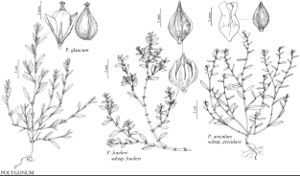Polygonum glaucum
Gen. N. Amer. Pl. 1: 254. 1818.
Plants silvery, homophyllous. Stems prostrate to ascending, branched from base, not wiry, 20–70 cm. Leaves: ocrea persistent, 7–15 mm, proximal part cylindric, pruinose, distal parts silvery, margins overlapping, entire or lacerate; petiole 0.5–3 mm; blade bluish green, lanceolate, 10–30 × 2–8 mm, coriaceous, margins revolute, apex obtuse or acute, rugulose when fresh, markedly rugulose when dried, glaucous; middle stem leaves slightly larger than adjacent branch leaves, distal leaves overtopping flowers they subtend. Inflorescences axillary; cymes uniformly distributed, 1–3-flowered. Pedicels enclosed in ocreae, 3–5 mm. Flowers semi-open; perianth (2–)3–4 mm; tube 12–26% of perianth length; tepals ± recurved, overlapping, white, margins white or pink, petaloid, not keeled, oblong-obovate to spatulate, not cucullate; midvein usually unbranched; stamens 8. Achenes exserted from perianth, reddish brown to dark brown, ovate, 3-gonous, 2.5–3(–4) mm, faces subequal, apex not beaked, edges straight, shiny, smooth; late-season achenes common, 3–5 mm. 2n = 40.
Phenology: Flowering Jul–Nov.
Habitat: Coastal beaches, sand dunes, margins of salt ponds
Elevation: 0-10 m
Distribution

Conn., Del., D.C., Fla., Ga., Md., Mass., N.J., N.Y., N.C., R.I., S.C., Va.
Discussion
Polygonum glaucum is restricted to maritime beaches along the Atlantic coast from Massachusetts south to Georgia. Over most of its range it is rare and declining; populations on coastal islands of Massachusetts and along the shore of Long Island appear to be secure. Seabeach knotweed appears to be related to P. oxyspermum.
Selected References
None.
